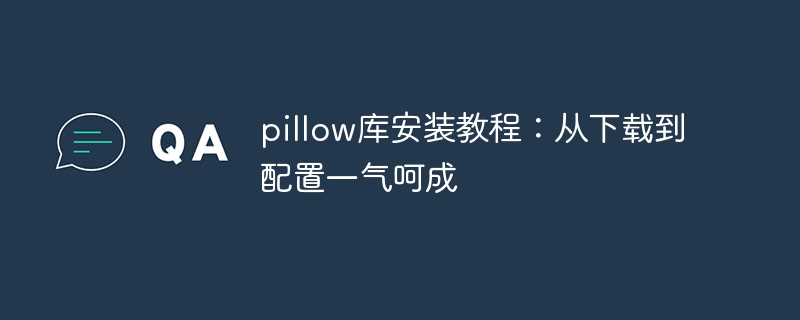

Pillow library is a very popular image processing library in Python, which can help us complete various image processing operations, such as image scaling, shearing, rotation, etc. This article will introduce you to the installation and configuration process of the Pillow library and provide detailed code examples.
1. Download and installation of Pillow library
Pillow library can be installed through the pip command. First, we need to make sure we have the Python interpreter installed. Open the command prompt and enter the following command to check the Python version:
python --version
If the version number of Python is displayed, Python has been installed correctly. Next, we can use the following command to install the Pillow library:
pip install pillow
After the installation is completed, we can start using the Pillow library for image processing operations.
2. Basic use of Pillow library
from PIL import Image
# 打开图像
image = Image.open('image.jpg')
# 显示图像
image.show()from PIL import Image
# 打开图像
image = Image.open('image.jpg')
# 调整图像大小为指定尺寸
new_image = image.resize((400, 300))
# 保存调整后的图像
new_image.save('resized_image.jpg')from PIL import Image
# 打开图像
image = Image.open('image.jpg')
# 剪切图像
cropped_image = image.crop((100, 100, 500, 400))
# 保存剪切后的图像
cropped_image.save('cropped_image.jpg')from PIL import Image
# 打开图像
image = Image.open('image.jpg')
# 旋转图像(逆时针旋转90度)
rotated_image = image.rotate(-90)
# 保存旋转后的图像
rotated_image.save('rotated_image.jpg')The above code example is only a small part of the use of functions in the Pillow library. Pillow also provides many other functions, such as image filter effects, color space conversion, text addition, etc. You can learn and practice in depth according to your own needs.
3. Configure the development environment
Before using the Pillow library, we need to configure the corresponding development environment. Before using the Pillow library, you need to ensure that the dependency packages of the Pillow library have been installed.
pip install wheel pip install setuptools pip install numpy
First, open PyCharm and click "File" on the top menu bar ” option and select “Settings”. In the pop-up window, expand the "Project" option and click "Project Interpreter". In the window on the right, click the " " button, then enter "Pillow" in the search box, and click the "Install Package" button to install.
4. Summary
This article introduces the installation and configuration process of the Pillow library in detail, and provides code examples for some common image processing operations. By learning and practicing these code examples, you can easily use the Pillow library to perform various image processing operations, such as image resizing, cropping, rotating, etc. Through continuous exploration, you can also discover more powerful functions provided by the Pillow library to help you better realize your image processing needs. I hope this article will help you learn and use the Pillow library!
The above is the detailed content of All in one go: Detailed tutorial on downloading and configuring the Pillow library. For more information, please follow other related articles on the PHP Chinese website!
 How to solve the problem that Apple cannot download more than 200 files
How to solve the problem that Apple cannot download more than 200 files
 python development tools
python development tools
 Introduction to html text box types
Introduction to html text box types
 Mathematical modeling software
Mathematical modeling software
 The difference between access and trunk ports
The difference between access and trunk ports
 Virtual currency exchange platform
Virtual currency exchange platform
 html set font color size
html set font color size
 Dogecoin trading platform
Dogecoin trading platform
 How to use panel control
How to use panel control




